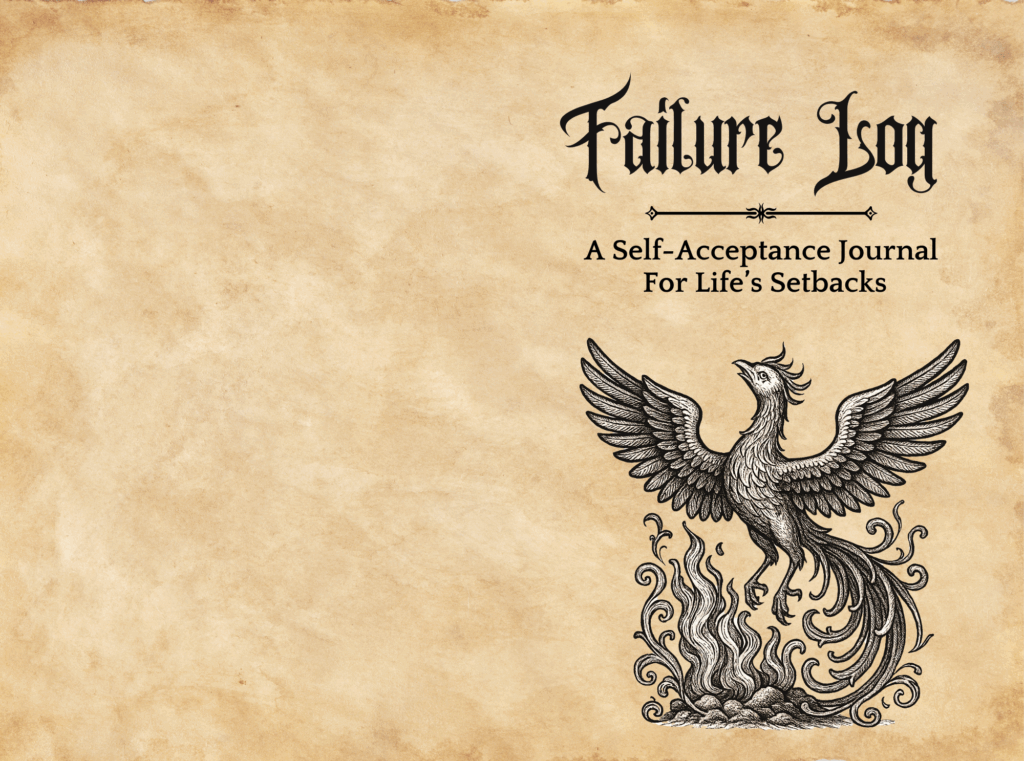
Last Tuesday, I completely bombed a presentation I’d been preparing for weeks. My mind went blank, I stumbled over simple words, and I watched my colleagues’ faces shift from expectant to uncomfortable. Sound familiar?
Most self-help advice tells you to keep a gratitude journal—write down three good things that happened each day. That’s fine advice, but it misses something crucial. Your failures, embarrassments, and mistakes contain some of the most valuable lessons you’ll ever learn. The problem? We spend so much energy trying to forget them that we never actually learn from them.
What if you flipped the script? Instead of just celebrating wins, what if you started documenting your losses, setbacks, and those moments that make you cringe when you replay them at 2 AM?
A Personal Failure Log does exactly that. It’s a systematic way to examine what went wrong, extract the lessons, and—most importantly—remind yourself that you survived. This isn’t about beating yourself up or dwelling on negative experiences. It’s about taking charge of how these experiences get stored in your memory and turning them into tools for growth.
Your brain naturally wants to either obsess over failures or completely bury them. Neither approach helps you improve. A failure log gives you a third option: honest reflection that leads to genuine self-acceptance and practical wisdom.
Ready to stop letting your mistakes control you? Let’s explore how documenting your failures can become one of your most powerful personal development tools.

The Problem with Avoiding Failure
Here’s what happens every time you try to forget a mistake: your brain files it away in the “unprocessed trauma” folder, where it sits and festers until something triggers the memory again.
Most of us handle failure in one of two equally unhelpful ways. We either replay the mistake endlessly, creating elaborate mental movies where we imagine all the ways it could have gone better. Or we shove it down deep and pretend it never happened, hoping time will make it disappear.
Neither approach works.
When you ruminate, you’re not actually solving anything—you’re just reinforcing the emotional charge around the event. Your brain creates deeper neural pathways associated with shame, regret, and self-criticism. Each replay makes the memory more painful, not less.
Avoidance seems smarter, but it backfires too. Psychologists have a name for what happens to our memories over time: rosy retrospection. We naturally edit our past experiences to make them seem better than they actually were. This sounds positive, but it’s actually problematic when it comes to learning.
If you sanitize your failures, you can’t learn from them. You end up repeating the same mistakes because you never honestly examined what went wrong in the first place. Worse, you start to believe your own edited version of events, which makes you less prepared for similar situations in the future.
The shame factor makes everything worse. We live in a culture that treats failure like a character flaw rather than a learning opportunity. This creates a vicious cycle: we feel ashamed of our mistakes, so we hide them, so we don’t learn from them, so we repeat them, so we feel more ashamed.
Your failures aren’t going anywhere. They’re part of your story whether you acknowledge them or not. The question is: will you let them teach you something useful, or will you let them control you from the shadows?

What is a Failure Log?
Your failures are about to become your secret weapon for personal growth, but only if you know how to use them properly.
A failure log is exactly what it sounds like: a written record of your mistakes, setbacks, and disappointments. But here’s the twist—instead of just documenting what went wrong, you systematically analyze each failure to extract useful insights and practice self-acceptance.
Think of it as the opposite of a gratitude journal. While gratitude journals focus on what’s going well, a failure log examines what isn’t working and why. The goal isn’t to wallow in negativity or punish yourself. It’s to create a structured process for learning from experiences your brain would rather forget or distort.
This approach draws from emotional exposure therapy, a proven psychological technique where you deliberately confront uncomfortable emotions instead of avoiding them. When you write about a failure soon after it happens, you’re essentially doing exposure therapy on yourself. You’re teaching your nervous system that thinking about this mistake won’t kill you.
The process also mirrors techniques used in Emotional Freedom Technique (EFT), where practitioners acknowledge difficult feelings while simultaneously affirming their self-worth. The key phrase in EFT is “I deeply and completely accept myself.” Your failure log works the same way—you examine what went wrong while reinforcing that you’re fundamentally okay regardless of the outcome.
Here’s what makes a failure log different from just complaining or venting: structure. Each entry follows a specific format designed to move you from emotional reaction to practical insight. You document what happened, identify your feelings, consider alternative approaches, extract lessons, and end with a statement of self-acceptance.
The magic happens when you start to see patterns. Maybe you consistently struggle with time management under pressure. Maybe you tend to people-please when you should set boundaries. These patterns only become visible when you have multiple failures documented in one place.
Your failure log becomes a personal database of hard-won wisdom—insights you literally couldn’t have gained any other way.

The Science Behind It
Your brain is wired to make failure as painful as possible, but you can actually rewire those pathways with the right approach.
When something goes wrong, your amygdala—the brain’s alarm system—floods your system with stress hormones. This creates what psychologists call “hot memories”: emotionally charged experiences that your brain stores differently than regular memories. Hot memories are vivid, intrusive, and they pop up at the worst possible times.
Writing about these experiences literally cools them down. Research from psychologist James Pennebaker shows that when you put emotional experiences into words, you activate your prefrontal cortex—the rational, analytical part of your brain. This creates new neural pathways that connect the emotional memory to logical understanding.
The act of writing forces your brain to organize scattered thoughts and feelings into coherent narratives. This process, called “meaning-making,” helps transform chaotic emotional experiences into structured information you can actually use.
There’s another fascinating mechanism at work: psychological distance. When you write about an experience, you automatically create some separation between yourself and the event. You shift from being inside the experience (reliving it emotionally) to being outside it (observing it analytically). This distance is crucial for learning.
Pattern recognition is where the real magic happens. Your brain is constantly looking for patterns, but it needs data to work with. Most people’s failure experiences exist as isolated emotional memories with no connection to each other. A failure log gives your brain what it needs to spot recurring themes and underlying causes.
Each time you complete a failure log entry, you’re essentially training yourself to handle setbacks better. You’re developing what researchers call “cognitive flexibility”—the ability to adapt your thinking when faced with new information or changing circumstances.
The self-acceptance component has its own neurological benefits. Studies show that self-compassion activates the parasympathetic nervous system, which promotes healing and growth. When you end each entry with an acceptance statement, you’re literally telling your nervous system that you’re safe despite the failure.
This isn’t just feel-good psychology—it’s neuroscience in action.

How to Create Your Own Failure Log
The most powerful personal development tool you’ll ever use fits in a simple notebook and takes 5-10 minutes per entry.
Your failure log doesn’t need fancy software or complicated systems. A basic notebook, a document on your phone, or even a simple text file works perfectly. The key is consistency and accessibility—you want to capture failures while they’re still fresh, before your brain starts editing the details.
Here’s the framework that turns any setback into actionable insight:
What happened? Write down the basic facts like you’re telling a friend. Skip the dramatic interpretation and stick to what actually occurred. “I forgot to prepare backup slides and my laptop crashed during the presentation” instead of “I completely humiliated myself in front of everyone.”
What emotions came up for you? Name your feelings without judgment. Embarrassment, frustration, anger, disappointment—whatever you felt is valid. Don’t try to be philosophical here. Just identify what emotions showed up.
If you could go back, what would you change about your approach? Focus only on what was within your control. You can’t change other people’s behavior or external circumstances, but you can usually identify something you could have done differently.
What insights or wisdom did this experience offer you? This is where the learning happens. What did you discover about yourself, your patterns, or how situations like this tend to unfold? Sometimes the insight is practical (“I need backup plans”), sometimes it’s deeper (“I care too much about what others think”).
Self-acceptance statement: End with a simple affirmation that you’re fundamentally okay regardless of this outcome. “If this happens again, I’ll handle it” or “Even if I mess up presentations again, I will be okay.” Choose whatever feels authentic for your situation.
Start with recent experiences that still bother you. Don’t worry if your first few entries feel awkward—like any skill, this gets easier with practice. The goal isn’t perfect analysis; it’s honest reflection that leads to genuine self-acceptance.
Set aside just ten minutes once a week to review any setbacks from the past few days. Regular practice prevents failures from piling up unprocessed in your mind.
Benefits You’ll Experience
Your relationship with failure is about to completely change, and the ripple effects will touch every area of your life.
The first thing you’ll notice is how much less scary failure becomes. When you know you have a system for processing setbacks, your brain stops treating every mistake like an existential threat. You develop what I call “failure confidence”—the quiet assurance that you can handle whatever goes wrong because you’ve done it before.
Your decision-making gets sharper too. Most people make choices based on avoiding failure rather than pursuing success. Once you’re comfortable with the possibility of things going wrong, you start making bolder, smarter decisions. You apply for jobs you’re not sure you’re qualified for. You have difficult conversations you’ve been avoiding. You try new approaches even when the outcome is uncertain.
The pattern recognition benefit is huge. After a few months of logging failures, you’ll start seeing your personal tendencies with crystal clarity. Maybe you consistently underestimate how long projects will take. Maybe you avoid conflict until situations explode. Maybe you people-please when you should set boundaries. These patterns are invisible until you document enough examples to make them obvious.
Self-criticism starts to fade naturally. When you practice examining failures without judgment, that objective mindset spills over into other areas. You stop beating yourself up for small mistakes because you’re trained to look for lessons instead of assigning blame. This isn’t about lowering your standards—it’s about channeling your energy toward improvement rather than self-punishment.
Your emotional regulation improves dramatically. Instead of getting hijacked by shame or embarrassment when something goes wrong, you have an automatic response: “I’ll process this later in my failure log.” This simple mental shift helps you stay functional in the moment instead of spiraling into emotional chaos.
Perhaps most importantly, you develop genuine resilience. Not the fake “everything happens for a reason” kind, but real resilience based on evidence. You have a written record proving that you’ve survived difficult situations before. This isn’t positive thinking—it’s documented proof of your ability to bounce back.
People around you will notice the change. You’ll become the person others come to when they’re struggling with setbacks, because you’ve mastered the art of learning from failure without drowning in it.

Final Words
Your failures have been trying to teach you something this whole time—you just haven’t been listening properly.
Most people spend their entire lives running from their mistakes, treating them like toxic waste that needs to be buried as deep as possible. But those same failures contain some of the most valuable information you’ll ever receive about yourself, your patterns, and how the world actually works.
A failure log changes everything. Instead of letting setbacks control your emotional state and decision-making from the shadows, you drag them into the light where they can actually be useful. You transform painful experiences into practical wisdom and genuine self-acceptance.
The data is clear: people who examine their failures systematically make better decisions, recover faster from setbacks, and develop authentic confidence based on real evidence of their resilience. They stop avoiding challenges because they’re comfortable with the possibility of things going wrong.
This isn’t about becoming failure-obsessed or pessimistic. It’s about developing a balanced relationship with difficulty—acknowledging that struggles are part of growth without making them mean something terrible about your worth as a person.
Your next setback is coming whether you’re prepared for it or not. The question is: will you let it derail you, or will you use it as raw material for becoming wiser and more resilient?
Start today. Think of something that went wrong recently—even something small that’s been nagging at you. Grab a notebook or open a document on your phone. Work through the five questions. See what happens when you treat your failure as data instead of evidence of personal inadequacy.
Your mistakes are waiting to become your teachers. All you have to do is give them permission to speak.
The next time something goes wrong, instead of thinking “Why does this always happen to me?” you’ll think “What can I learn from this?” That shift in perspective changes everything.
You may also be interested in:
1. EFT Tapping For Self-Love
2. Talk to Yourself Like You Would to Someone You Love
3. 5 Letting Go Exercises That You Should Practice Every Day

